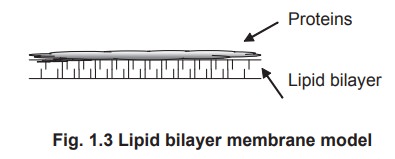Chapter: Biochemistry: Cell Membrane
Models proposed for the plasma membrane
Models proposed for the plasma membrane
1. Monolayer Model
Overton was the pioneer to postulate that plasma
membrane is a thin layer of lipid. He proposed this because he found that lipid
soluble substances are easily transported across the membrane.
2. Lipid Bilayer Model
The amount of lipids present in the erythrocyte
membrane was nearly twice that of its total surface area. This made Gorten and
Grendel to propose that lipids in the membrane exist as bilayers.

3. Unit Membrane Model
This model was proposed by Davson and Danielli
and was shaped by Robertson. Experiments showed that the surface tension of the
biological membranes are lower than that of the pure lipid bilayers, suggesting
the presence of proteins in them. Based upon this, Davson and Danielli proposed
that proteins are smeared over the lipid bilayer.

When electron microscope was invented, plasma
membrane appeared as three layers. With this observation, Robertson formulated
a unit membrane model, which states that the proteins are present on either
side of the lipid bilayer. According to this model, the membrane will be like a
lipid layer sandwiched between two protein layers.
4. Fluid Mosaic model
This is the universally accepted model for
plasma membrane. On the basis of several experiments, S.J. Singer and G.L.
Nicolson in 1972 proposed this model.
The essential features of the Fluid mosaic model
are
·
Lipids
and proteins are present in a mosaic arrangement within the bilayer.
·
Phospholipids
act as a fluid matrix, in which some proteins are integral and others are
associated with the surface of the membrane.
·
Lipids
and proteins are mobile in the membrane.
·
They
can move laterally, rotate but not from one monolayer to the other.
·
The
membrane is asymmetric in nature, the outer and inner leaflets of the bilayer
differ in composition.
Related Topics